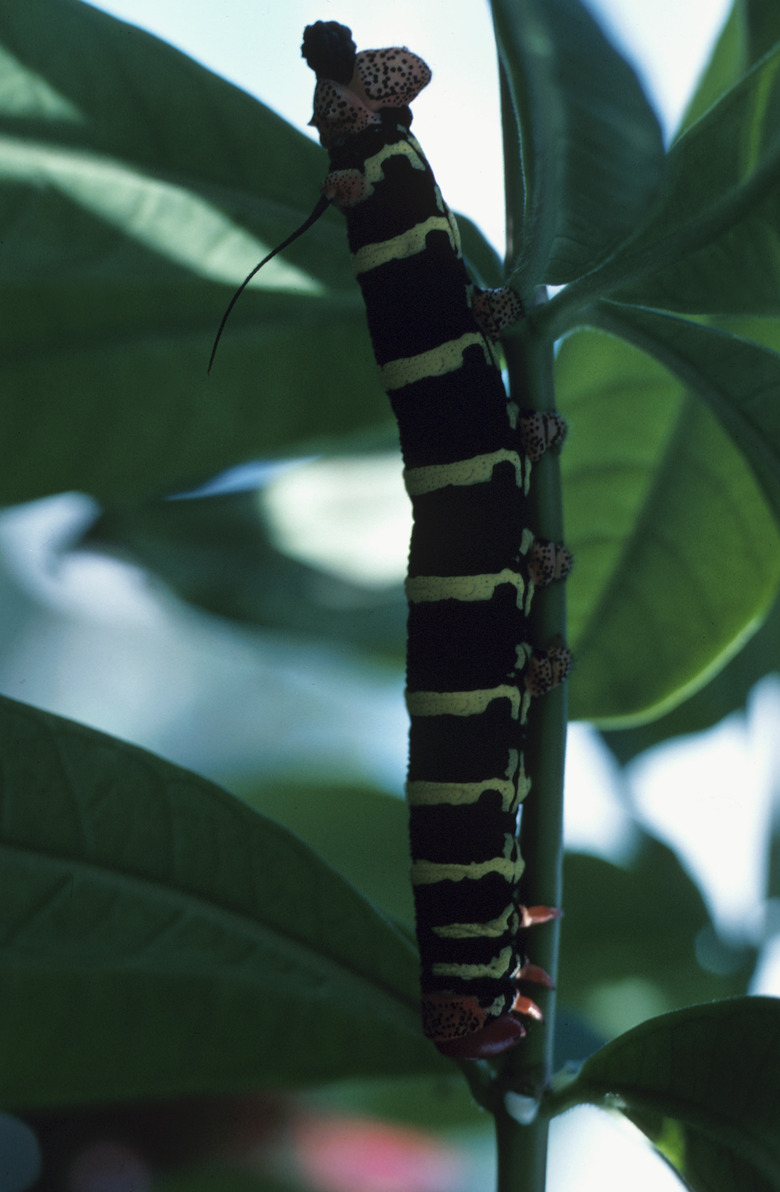Are Black & Yellow Tree Caterpillars Poisonous?
Several species of black and yellow caterpillars live on trees in the United States. Most of them are not poisonous to people or pets. However, at least one variety of black and yellow tree caterpillar requires handling with care because of its irritating hairs. Two other species that live on plants near the ground contain small amounts of a heart poison that could harm some people and small animals.
Yellownecked Caterpillar
Yellownecked Caterpillar
The yellownecked caterpillar, or Datana ministra, is a nonpoisonous species found across the United States. At maturity, the yellownecked caterpillar has a two-inch black body with yellow stripes running its full length, as well as a yellow neck.
Though the yellownecked caterpillar won't harm people or pets who ingest or touch it, the insect can damage trees. The yellownecked caterpillar is partial to oaks, elms and hickories, and colonies of hundreds of caterpillars can defoliate a young tree in one summer.
Control yellownecked caterpillars by cutting off and destroying infested tree branches. Insecticides containing the toxic bacteria Bacillus thuringiensis can quell yellownecked caterpillar outbreaks if you apply the compounds when caterpillars emerge in mid-summer.
Azalea Caterpillar
Azalea Caterpillar
The azalea caterpillar, a close relative of the yellownecked caterpillar, lives west of the Rocky Mountains, where it feasts on azalea trees, oaks and apple trees. The azalea caterpillar's black body grows to two inches, with eight broken yellow and white stripes from front to back. Its head, neck and legs are bright red.
Azalea caterpillars reach peak activity in late summer and early fall. They're harmless to people and animals. Controls include the pesticide Sevin Dust, as well as insecticides containing Bacillus thuringiensis, malathion or cyfluthrin.
Catalpa Sphinx Caterpillar
Catalpa Sphinx Caterpillar
Elm, catalpa and apple trees are favorites of the catalpa sphinx caterpillar, or Ceratomia catalpae, a hornworm species that grows a black spike on the end of its body. The catalpa sphinx grows to three inches, and has a black body with pale yellow stripes running the length of its sides.
Catalpa sphinx caterpillars are not poisonous to people or pets, though they can strip trees of their leaves. The caterpillars, also called Catawba worms, are bred commercially on catalpa farms and used as fish bait. Control them manually by picking them out of trees and stepping on them.
Spotted Tussock Caterpillar
Spotted Tussock Caterpillar
The spotted tussock caterpillar's signature trait is its hair, which covers its body in black and yellow bands. Longer, white hairs protrude from the caterpillar's front and back.
It's tempting to pick up the fuzzy spotted tussock, or Lophocampa maculata, but its hairs can irritate the skin in people with allergies. The spotted tussock grows to 1.5 inches and lives in warmer climates in the United States, including in the south and California.
You'll find the spotted tussock caterpillar feasting on poplars, maples and oaks, but its numbers are not high enough to cause serious harm to trees. Environmental controls are unnecessary.
Poisonous Caterpillars
Poisonous Caterpillars
Two varieties of black and yellow caterpillars contain cardenolides, or poisonous alkaloids related to the heart stimulant digitalis. They don't live in trees, but if you're watching out for potentially toxic caterpillars, you should know about the monarch caterpillar, or Danaus plexippus, and the cinnabar moth caterpillar, or Tyria Jacobaeae.
The monarch caterpillar grows to two inches and has black, yellow and white stripes running horizontally across its body. The monarch feeds exclusively on milkweed, a ground-dwelling vine that contains cardenolides.
Cinnabar moth caterpillars grow to about one inch, and have black and yellow horizontal stripes. They feed on the tansy ragwort, which also contains cardenolides.
Both caterpillars store cardenolides in their bodies. A human would have to consume large numbers of these caterpillars to develop heart trouble, but many animals, including birds and rodents, are more vulnerable to poisoning from cardenolides because they are small.
Cite This Article
MLA
Alyson, Jennifer. "Are Black & Yellow Tree Caterpillars Poisonous?" sciencing.com, https://www.sciencing.com/are-black-yellow-tree-caterpillars-poisonous-12573507/. 30 September 2021.
APA
Alyson, Jennifer. (2021, September 30). Are Black & Yellow Tree Caterpillars Poisonous?. sciencing.com. Retrieved from https://www.sciencing.com/are-black-yellow-tree-caterpillars-poisonous-12573507/
Chicago
Alyson, Jennifer. Are Black & Yellow Tree Caterpillars Poisonous? last modified August 30, 2022. https://www.sciencing.com/are-black-yellow-tree-caterpillars-poisonous-12573507/
